The best type of art? Temple-ted! Step back in history and marvel at the intricate, finely crafted sculptures of the Temples of Khajuraho – they deserve to be seen to be appreciated, and marvelled about.
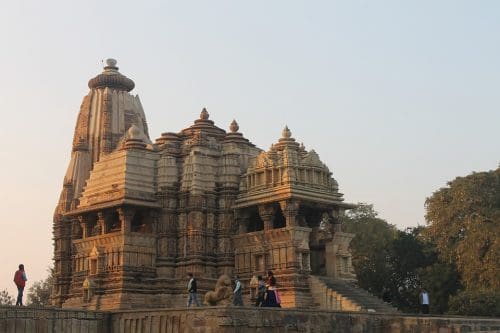
The Temples of Khajuraho, a UNESCO World Heritage site in Madhya Pradesh, have long been renowned for their incredibly detailed sculptures, particularly their erotic carvings. which are considered some of the finest artworks from that era. These temples contain magnificent masterpieces adorning the walls – a visual testament to artistic excellence.
From 900 to 1130 CE, the Chandela Rulers of Khajuraho constructed 85 extraordinary temples that were celebrated by renowned scholars such as Abu Rahyan al Biruni in 1022 CE and Ibn Batuta in 1335 CE. These remarkable structures harmoniously blended Hinduism’s Shaivism sect with Vaishnavism and Jainism beliefs – a feat unparalleled for its time! Yet sadly, over the centuries only 20 have managed to remain intact today- each one still admired for its breathtaking artistry and striking architecture.
Why are erotic sculptures crafted on the Khajuraho temple walls?
The Khajuraho temples were built between 950-1050 CE, by the Chandela dynasty but they were largely unknown to the world until the late 19th and early 20th centuries. In the late 1800s, British army officer T.S. Burt stumbled upon the temples and wrote about his discovery. His accounts sparked international interest in the temples and their erotic sculptures, which were seen as a unique and fascinating aspect of India’s cultural heritage.
Over the following decades, the temples became a popular tourist destination, attracting visitors from around the world to see the intricate carvings and sculptures.
Why erotic sculptures one may well ask. The erotic sculptures on the walls of the Khajuraho temple in India are believed to depict human desire, love, and fertility. They are also considered to symbolize the spiritual union between the individual soul and the divine. The temple sculptures are thought to reflect the cultural and societal values of the time, by depicting sexual acts, affection, and sensuality as integral and celebrated aspects of life.
They were created during a period of great cultural creativity in India and symbolize the acceptance of human sexuality as a natural and divine aspect of life. Additionally, the sculptures are seen as a representation of the interconnectedness of physical pleasure and spiritual enlightenment.
The Devi Jagdambi temple is renowned for its unique collection of sculptures depicting devanganas, mithunas and divinities – including a variety of explicit erotic artworks. Although many mistakenly believe these works showcase deities engaging in lovemaking, they actually show passionate interactions between humans and changes to their physical forms. These representations help us understand the ancient human experience through an intriguing artistic form that graces both the exterior and interior walls of this legendary temple complex – often referred to as the Kama Sutra Temples.
These temples celebrate womanhood with beautiful and intricate sculptures of voluptuous women known as apsaras adorning their walls. Here, nymphs were depicted in captivating poses putting on make-up, washing hair or playing games; all crafted to perfection according to authoritative religious texts like Shilpashastras and Brihat Samhita that deemed these erotic motifs protective and auspicious.
Temples of Khajuraho – intricate sculptures and carvings
The major focus of the study of the Temples of Khajuraho has been on the sculptures. The walls of these temples have some of the best sculptures of the time, making Khajuraho a representation of excellent artistic features.
The Temples of Khajuraho are renowned for their sensual sculptures, such as the celestial nymphs with wide hips, full breasts, and captivating eyes at Kandariya Mahadeva and Vishwanath Temple. These carvings signify female beauty and fertility in Hindu culture – extending even further to illustrate how sexual procreation is an integral part of our lives on the walls of these temples through Narathara (the human life cycle).
The Chandelas were also deeply interested in performance arts and the various forms of music and dance. This is evident from the sculptural representation of various scenes of music and dance depicted on the walls of these temples.
The carvings at the temples seem to be predominantly about Hindu deities and mythology. All the temples of Khajuraho have been built facing the sun. Moreover, the carvings reflect the four goals of life in Hinduism, viz, dharma, kama, artha, moksha.
The Temples are believed to have been built of light-colored sandstone imported from the quarries of Panna, from the bank of the Kane River. The Temples of Khajuraho are divided into three groups, the Western Group, the Eastern Group and the Southern Group. The Western Group of Temples are situated on the west of the Bamitha-Rajnagar road on the banks of Sib-Sagar.
They comprise major edifices and are dedicated to the Shaivite and Vaishnavite cults.
The Western Group of Temples
- Chausath Yogini Temple: dedicated to goddess Kali, the oldest granite temple in Khajuraho.
- Kandariya Mahadeva Temple: the largest temple in Khajuraho and considered to be one of the finest examples of Hindu temple architecture.
- Lakshmana Temple: known for its delicate sculptures and intricate carvings.
- Matangeshwara Temple: dedicated to the Hindu god Shiva and features a towering lingam.
- The Devi Jagdamba Temple in Khajuraho is dedicated to the Hindu goddess Durga
- The Chitragupta or Bharatji Temple is dedicated to the Hindu sun god Surya
- The Vishwanath Temple in Khajuraho is dedicated to the Hindu god Shiva
The Chausath Yogini Temple in Khajuraho is dedicated to the Hindu goddess Kali, it is the oldest granite temple in the area. It is a small and compact shrine but is considered to be a significant example of early Hindu temple architecture in India.
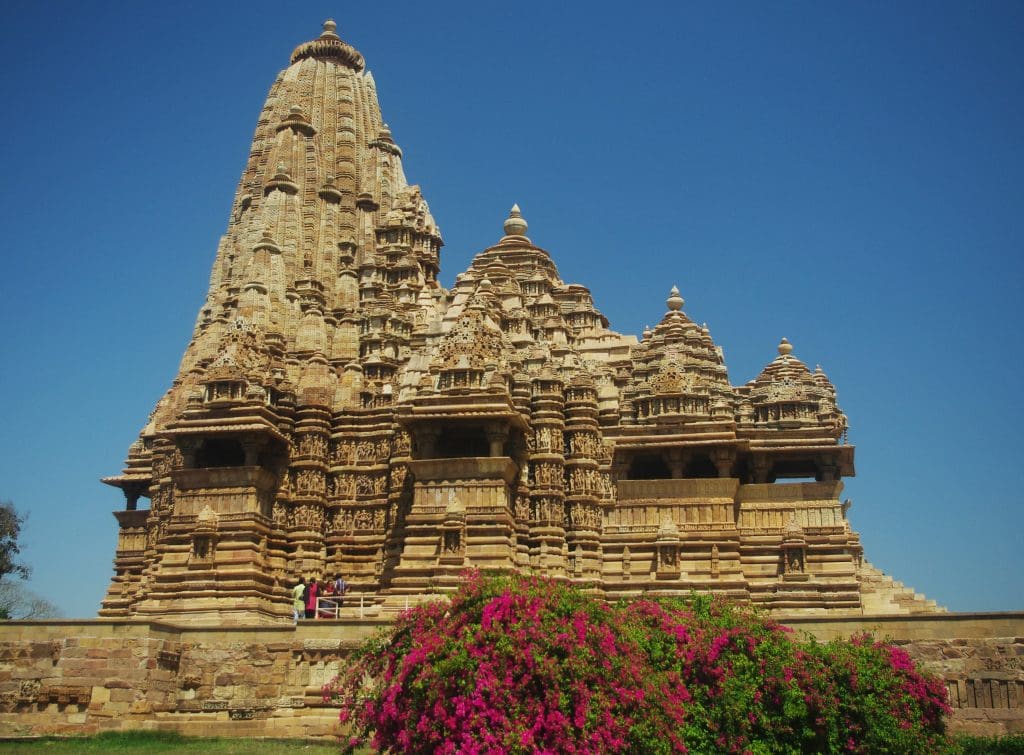
The Kandariya Mahadeva Temple is considered to be one of the finest examples of Hindu temple architecture and is the largest temple in Khajuraho. It is known for its elaborately carved towers, intricate sculptures, and stunning dome. The temple is dedicated to Lord Shiva and its tall spire is a notable feature of the temple’s architecture.
The Lakshmana Temple is a beautifully crafted shrine, known for its delicate sculptures and intricate carvings. The temple features ornate columns and intricate relief work on its walls. The temple is dedicated to Lord Vishnu and is considered to be one of the most beautiful temples in Khajuraho.
The Matangeshwara Temple is dedicated to the Hindu god Shiva and features a towering lingam as its central deity. The temple is known for its intricate carvings and sculptures, which adorn its walls and columns. The temple is considered to be a significant example of Hindu temple architecture in India.
The Devi Jagdamba Temple in Khajuraho is dedicated to the Hindu goddess Durga and is known for its intricate carvings and sculptures. The temple features stunning relief work on its walls, depicting various Hindu gods and goddesses. The temple is also known for its beautifully carved entrance.
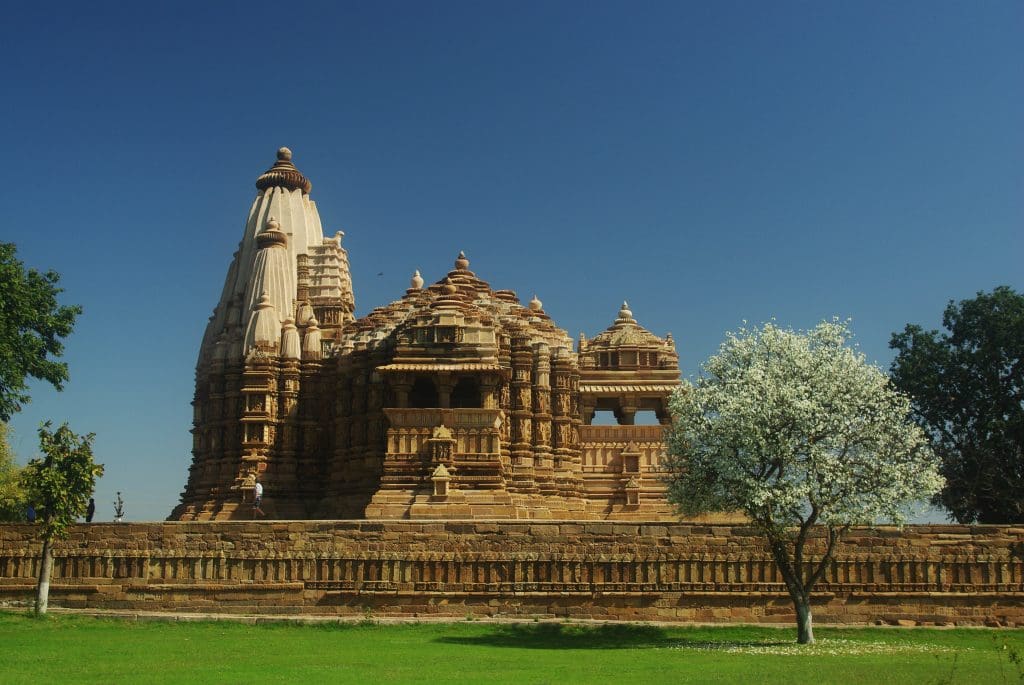
The Chitragupta or Bharatji Temple is dedicated to the Hindu sun god Surya and features intricate sculptures of Hindu gods and goddesses. The temple is considered to be a significant example of Hindu temple architecture in India.
The Vishwanath Temple in Khajuraho is dedicated to the Hindu god Shiva and is known for its intricate carvings and sculptures. The temple features ornate columns and intricate relief work on its walls. The temple of Khajuraho famous for Lord Shiva is also known for its large and impressive shivling, which is considered to be one of the largest in Khajuraho.
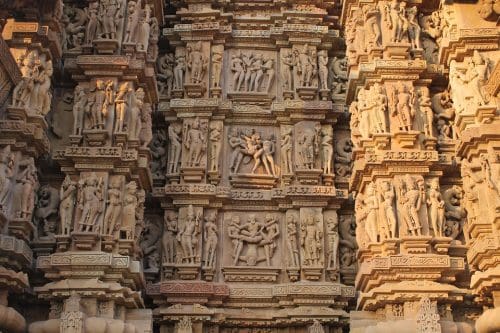
The Eastern Group of Temples
The complex comprises
- Three Hindu temples- Brahma, Vamana, and Javari.
- Two large Jain temples- the Ghantai temple, and the Parsawanatha Jain temple.
The Brahma Temple in Khajuraho is dedicated to the Hindu god Brahma and is known for its intricate carvings and sculptures. The temple features a large statue of Lord Brahma, which is considered to be one of the largest in India. The temple is also known for its elaborate entrance, which showcases the artistic skills of the artisans who built it.
The Vamana Temple in Khajuraho is dedicated to the Hindu god Vishnu and is known for its intricate carvings and sculptures. The temple features ornate columns and intricate relief work on its walls, showcasing the artistic skills of the artisans who built it. The temple is also known for its large statue of Lord Vishnu, which is considered to be one of the largest in India.
The Ghantai Temple in Khajuraho is a Jain temple and is known for its intricate carvings and sculptures, particularly its sculptures of Jain Tirthankaras. The temple is also known for its elaborate entrance, which showcases the artistic skills of the artisans who built it. The temple is considered to be a significant example of Jain temple architecture in India.
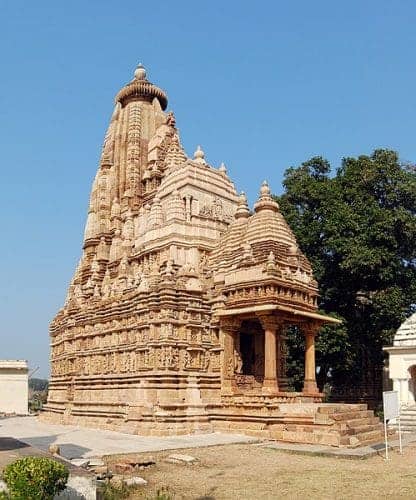
The Parsawanatha Jain Temple in Khajuraho is dedicated to the Jain Tirthankara Parshvanatha and is known for its intricate carvings and sculptures. The temple is also known for its elaborate entrance, which showcases the artistic skills of the artisans who built it. The temple is considered to be a significant example of Jain temple architecture in India.
The Southern Group consists of two temples, the Duladeo and the Jatkari temple
These Temples in Khajuraho are famous for their intricate and elaborate architecture, sculptures, and carvings. Each temple is dedicated to a different Hindu deity and showcases the artistic skills of the artisans who built them. The Duladeo temple is revered on account of its beautiful statue of Lord Shiva, while the Jatkari temple is known for its large statue of Lord Vishnu, about 9 feet in height, presented as four-armed (Chaturbhuja) adorned with a crown and other ornaments. which is considered to be one of the largest in India.

The large statues of Lord Shiva and Lord Vishnu in these temples are considered to be among the largest in India.
Unknown facts about the temples of Khajuraho
Khajuraho is known for its ancient temples that are scattered across the region. While most people are aware of the famous sculptures and carvings adorning these temples, there are many lesser-known facts about them that make them even more interesting.
- The two oldest temples in Khajuraho, Kandariya Mahadev and Chaturbhuj, are over a thousand years old.
- The temples were built with sandstone blocks that weighed up to 20 tons each!
- How many temples are there in Khajuraho? Of the original 85 temples in the Khajuraho complex, only 25 have survived
- There is an interesting astronomical alignment between the three main temples of Khajuraho – Kandariya Mahadev, Chaturbhuj and Lakshmana.
- The temples are built on the banks of two rivers – Khajuraho and Ken.
- Many of the sculptures on the walls of these temples have musical instruments, suggesting that music was an important part of religious ceremonies held inside them.
- There are also many sculptures of animals, including elephants and horses.
- The temples have intricate stone carvings depicting scenes from Hindu mythology as well as scenes from everyday life.
- These temples are made up of several smaller shrines, each dedicated to a particular deity.
- There is also evidence that suggests the presence of a Buddhist monastery at the site.
- The temples contain several Sanskrit inscriptions, offering insight into the history of Khajuraho and its rulers.
The temples of Khajuraho are not only a great example of ancient Indian architecture and art, but they also offer an insight into the culture and history of the region. These temples are truly remarkable and worth exploring!
Read More: Latest



